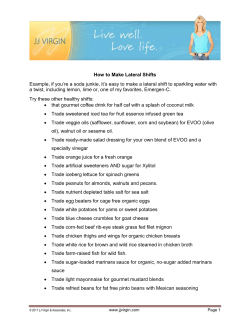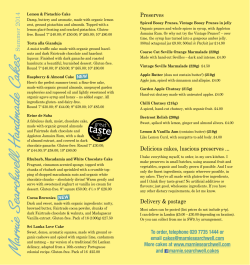
COVER SHEET
COVER SHEET This is the author version of article published as: Yu, Zhong-Zhen and Yan, Cheng and Yang, Mingshu and Mai, Yiu-wing (2004) Mechanical and dynamic mechanical properties of nylon 66/montmorillonite nanocomposites fabricated by melt compounding. Polymer International 53(8):pp. 1093-1098. Copyright 2004 Wiley Accessed from http://eprints.qut.edu.au Mechanical and dynamic mechanical properties of nylon 66/montmorillonite nanocomposites fabricated by melt compounding ZHONG-ZHEN YU,1 CHENG YAN,1 MINGSHU YANG,1,2 YIU-WING MAI1 1 Center for Advanced Materials Technology, School of Aerospace, Mechanical and Mechatronic Engineering J07, The University of Sydney, NSW 2006, Australia 2 State Key laboratory of Engineering Plastics, Center for Molecular Science, Institute of Chemistry, Chinese Academy of Sciences, P.O. Box 2709, Beijing 100080, China Corresponding author: Dr. Zhong-Zhen Yu Centre for Advanced Materials Technology School of Aerospace, Mechanical and Mechatronic Engineering J07 The University of Sydney Sydney, NSW 2006 Australia Tel: +61-2-93517149 Fax: +061-2-93517060 E-mail: zhongzhen.yu@aeromech.usyd.edu.au 1 Abstract: Nylon 66 nanocomposites were prepared by melt compounding of nylon 66 with organically modified montmorillonite (MMT). The organic MMT was pre-modified with about 14 wt% of ammonium surfactant, much lower than 35-46 wt% in most commercial organic MMT powders. Transmission electron microscope observation indicated that the MMT layers were well exfoliated in nylon 66 matrix. Dynamic mechanical analysis confirmed the constraint effect of exfoliated MMT layers on nylon 66 chains, which benefited the increased storage modulus, increased glass transition temperature and reduced magnitude of alpha relaxation peak. The effects of organic MMT loading levels on reinforcement and fracture behaviour of the nanocomposites were evaluated using tensile and three-point bending tests. The addition of the organic MMT clearly increased Young’s modulus and tensile strength but decreased ductility and fracture toughness of nylon 66. Keywords: nylon 66; nanocomposite; montmorillonite; exfoliation; fracture toughness 2 INTRODUCTION Polymer/montmorillonite (MMT) nanocomposites have created much interest since Toyota’s group developed nylon 6/MMT nanocomposites via in situ polymerization in 1987, in which MMT layers were fully exfoliated to 1 nm thick individual layers with other dimensions in 100-1000 nm range and dispersed in nylon 6 matrix [1-3]. This interest stems from the fact that, once the MMT layers in a polymer matrix was fully exfoliated, only a few percent of MMT resulted in a broad range of property improvements, e.g. increased stiffness and strength, improved solvent resistance, enhanced gas barrier properties [4]. To-date, the use of MMT as a dispersed phase to prepare nanocomposites has been extended to various polymers such as epoxies [5-7], polypropylene [8-11], polystyrene [12-14], polyimide [15-17], polyethylene terephthalate [18], polyurethanes [19], polycarbonate [20], and nylon 12 [2122]. Generally, the MMT layers are not easily exfoliated in most polymers due to strong electro-static forces between them and chemical incompatibility of the MMT surface with polymers. Long chain alkyl ammonium surfactants were usually employed to pre-modify the MMT interlayer galleries through cation-exchange reactions so as to weaken the interaction between adjacent layers and to enhance the compatibility/wettability of MMT layer with the polymer matrix. Based on the cation-exchange capacity of MMT, the content of the alkyl ammonium surfactant in organic MMT was usually about 35 - 46 wt% [23-28]. Typically, even with 5 wt% of the organic MMT, the surfactant would constitute a mass fraction of about 2-3 wt% of the nanocomposite. The presence of so large proportion of the low molecular weight surfactant, which usually has no strong interaction with the polymer matrix 3 in most cases, may greatly affect the reinforcing efficiency of the MMT layers and thermal stability of the final product even if all the MMT layers are fully exfoliated. We developed an organic MMT (O-MMT) with much lower organic surfactant content, approximately 14 wt%. In a previous report [29], the dispersion and spatial distribution of the MMT layers in an injection-moulded rectangular bar of nylon 66/organic MMT nanocomposite were characterized by X-ray diffraction. Most MMT layers were orientated along the injection moulding direction. MMT layers near the four surfaces of the rectangular bar were predominantly parallel to their corresponding surfaces. Whereas, the MMT layers in the bulk distributed randomly, but they were still parallel to the injection moulding direction. The influence of the MMT layers on crystallization behaviour of nylon 66 was reported in another report [30]. The presence of MMT layers increased the crystallization temperature of nylon 66 because of the heterogeneous nucleation of MMT. The crystallite sizes L100 and L010 of nylon 66, determined by WAXD, decreased with increasing MMT content. Obvious decreases in dimension of spherulites of nylon 66 due to the addition of the MMT layers were directly confirmed by polarizing optical microscopy. The purpose of the present work is to investigate the influence of the organic MMT on reinforcement and fracture toughness of nylon 66. EXPERIMENTAL Materials and melt compounding Nylon 66 pellets were supplied by Liaoyang Petrochemical Fiber Co. (China) with number average molecular weight of 1.67 × 104. The pristine sodium MMT with cation exchange capacity of 85 mequiv/100 g was from Zhangjiakou Clay Mineral Corporation (China). The MMT was firstly modified with chlorosilane derivative in organic solvent in order to modify the MMT surface and decrease its cation exchange capacity, and then modified with organic 4 ammonium by cation exchange reaction. The detailed process for MMT modification was reported elsewhere [29]. Prior to blending, the organic MMT and nylon 66 were dried for 6 h under vacuum condition at 80 and 100oC, respectively. The nylon66/organic MMT compounds were prepared using a twin-screw extruder (SHJ-30) with a 30-mm diameter and an L/D ratio of 23.2. The screw speed and the barrel temperatures of the extruder were 250 rpm and 260280oC, respectively. The extrudates were pelletized at the die exit, dried and then injection moulded into rectangular bars (127 mm length, 12.7 mm width, and 12.7 mm thickness) in an injection moulding machine (SZ-160/80) for morphological and mechanical characterizations. Transmission electron microscope observation The specimen of nylon66/MMT nanocomposites for TEM observation was taken from a cross-section perpendicular to the flow direction of an extrudate rod. Ultra-thin sections ranging from 50-80 nm in thickness were cryogenically cut with a diamond knife under liquid nitrogen environment using a Reichert-Jung Ultracut E microtome. Sections were collected on 300 mesh copper TEM grids and subsequently dried with filter paper. The sections were examined by a Hitachi-800 TEM at an accelerating voltage of 22 kV. Mechanical characterization The tensile tests were carried out on the dumbbell-shaped specimens with an Instron 5567 computerized testing machine in accordance with the ASTM standard D638-99. The yield strength, Young’s modulus, and elongation at break were measured at a crosshead speed of 50 mm/min. Three-point blend specimens were used to measure the fracture toughness. The critical stress field intensity factor (KIC) was calculated from the failure load according to ASTM standard D5045-99. The detailed dimension of the three-point bend specimen was described in the references [31-32]. The fracture surfaces of the three-point bend specimen 5 were observed using a scanning electron microscope (SEM). Dynamic mechanical properties were measured on a TA instruments Dynamic Mechanical Analyzer system (DMA-2980) under a single-cantilever mode. The heating rate and frequency were 3oC/min and 1 Hz, respectively. RESULTS AND DISCUSSION Exfoliation of MMT layers Fig. 1 shows the TEM images taken from a cross-section perpendicular to the flow direction of the extruded rods of the nylon 66/organic MMT nanocomposites. The dark lines represent the intersection of MMT layers and the white background represents nylon 66 matrix. It is seen that most of the MMT layers were well exfoliated into individual layers or some thin stacks containing a few layers. The thickness of the MMT platelets is about a few nanometers, while the average length is about 90 nm. Besides, just intersections of MMT layers were observed in the TEM graphs, which was caused by the highly orientation of MMT layers along the flow direction due to high aspect ratio of MMT layers. The preferential orientation of MMT layers in nylon films and injection molded bars was observed [27-29, 33-35]. Dynamic mechanical analysis Fig. 2 shows the storage modulus and dynamic loss as a function of temperature for the nylon 66/organic MMT nanocomposites. Apparently, the organic MMT increased storage modulus of nylon 66 throughout the temperature range. This increase is accordance with the variation of Young’s modulus obtained from tensile test, where the Young’s modulus at ambient temperature also gradually increased with the organic MMT loading level. The modulus improvement should be due to the stiffness of MMT layers as well as the constraining effect by the exfoliated MMT layers on molecular motion of nylon 66 chains. Usuki et al. [3] 6 studied the constraint effect of nylon 6 chains with exfoliated MMT layers. Specially, the constrained volume in nylon 6 nanocomposite with 5 wt% organic MMT was over 30%, which was responsible for the remarkable enhancement of mechanical properties [3]. Due to the reinforcement of the exfoliated MMT layers, the glass transition temperature was slightly increased, compared to that of nylon 66. This was not consistent with the results on nylon 6/organic MMT nanocomposites [36], in which the glass transition temperature of nylon 6 was shifted toward lower temperature by about 10oC. The decrease of the glass transition temperature was mainly caused by the two reasons. Firstly, the content of alkyl ammonium surfactant in the organic MMT used in their work was too high, about 46%. Part of the surfactant was not intercalated into the galleries of MMT and was just adsorbed outside of the galleries and served as a plasticizer during compounding of the organic MMT with nylon 6 melt. Secondly, the alkyl ammonium surfactant in the organic MMT, not having good affinity with polar nylon 6, created a hydrophobic environment at MMT surface and shielded the thermodynamic interaction between nylon 6 and MMT. Tanaka and Goetter [37] reported by molecular modelling that the pristine MMT had highest binding strength to nylon 66. Organic modification of MMT with alkyl ammonium surfactant reduced its binding energy with nylon 66 due to the shielding effect of the surfactant. The importance of the polar interaction between polymer and MMT was extensively stressed even in preparation of nonpolar polymer system such as polypropylene with organic MMT, in which a maleic anhydride grafted propylene oligomer was incorporated as a compatibilizer [8, 38-39]. In the current work, as the organic surfactant content in the organic MMT was just 14 wt%, much lower than 35-46 wt% of some commercial organic MMTs, both the plasticizing and shielding effects were less serious, therefore, the nylon 66 had an opportunity to interact with polar sites on the MMT layers, which was believed to benefit Tg increase of the nylon 66/MMT nanocomposites. It should be pointed out that, although the organic surfactant shielded 7 favourable polar interaction between nylon 66 and MMT, it does not mean it is not necessary to pre-modify MMT. Generally there are two purposes of organically modification of MMT before melt compounding. The first is to weaken the polar interaction between adjacent MMT layers and enlarge distances between MMT layers, which is a prerequisite for polymer macromolecules to intercalate into the MMT galleries. The second is to enhance affinity/compatibility between polymer and MMT, which provides a driving force for polymers to migrate into the MMT galleries. Up to now, most popular surfactants used to organically modify MMT were alkyl ammonium cations, which may not be the best to some high temperature polar engineering plastics [29, 40-41]. Exploring novel surfactants has already been initiated [42]. The area and magnitude of the alpha loss tangent peak is a reflection of polymer chain motion of amorphous phase. The largely reduced magnitude and area of the peak was mainly caused by the constrained nylon 66 with the exfoliated MMT and the reduction of volume fraction of nylon 66 in the nanocomposites. Besides, the change of crystallite dimension of nylon 66 also affected the loss peak. As confirmed by polarized light microscopy [30], the crystallite dimension of nylon 66 was greatly reduced by the organic MMT. At a fixed volume fraction, smaller crystallites produced more interfacial area, and thus constrained polymer chains movements within amorphous phase more thoroughly than lager crystallites. More restraint of tie chains between crystallites would facilitate the decrease of magnitude of the alpha loss tangent peak and the increase of Tg. Additionally, it was also seen from Fig. 2(b), when the temperature was above the glass transition temperatures of nylon 6 nanocomposites, the magnitude of dynamic loss increased with the organic MMT contents. At this range of temperature, the amorphous phase of nylon 66 was in rubbery state, its molecular relaxation was enhanced due to the plasticizing 8 effect of surfactant on MMT surface. Such phenomenon was also observed in other polymer/ organic MMT nanocomposites [36, 43]. Mechanical properties The reinforcing effect of the organic MMT on nylon 66 was evaluated by tensile properties. Fig. 3 shows the yield strength and Young’s modulus of the nylon 66 nanocomposites as a function of organic MMT content. Both the Young’s modulus and yield strength of nylon 66 are dramatically improved with increasing the organic MMT loading. At the organic MMT content of 10 wt%, The Young’s modulus was doubled and the yield strength increased by 20 wt%. This represents a substantial improvement. Fig. 4 shows the variation of elongation at the break as a function of the organic MMT content. As expected, there was a large drop of the elongation at break with the increase of organic MMT content. This result was a little different from that in nylon 6/organic MMT system, where the elongation at break remained at the levels of pristine nylon 6 up to adding 5 wt% of the organoclay and then sharply decreased thereafter [24]. As mentioned before, the critical stress intensity factor, KIC was calculated from the failure load in the three-point bend testing. The variation of KIC with the MMT loading was shown in Fig. 5. There was a large scatter of the data, especially for the samples at high organic MMT loading (10 wt%). Conventionally, the lower bound toughness was employed for conservative safety assessment of engineering materials and structures. It was showed a slight decrease of the lower bound fracture toughness with the increase the organic MMT amount. Fig. 6 shows the SEM micrographs of fracture surfaces of the three-point bend specimens. The notch was at the top of each image and the crack propagation direction was downwards. At low MMT content (< 5 wt%), the fracture surface exhibited many river marks and ductile matrix tearing, which were indicative of the occurrence of plastic shear 9 deformation [Fig. 6 (a) - (c)]. In contrast, the fracture surface of the specimen with 10 wt% of the organic MMT became smooth and brittle like, indicating little plastic deformation associated with the fracture initiation [Fig. 6(d)]. This was consistent with the variation of fracture toughness with the organic MMT loading. Although only a few precent of organic MMT gave a marked reinforcement to nylon 66, its negative effect on ductility and toughness should also be concerned. To get a reinforced and toughened nylon/clay nanocomposite, a nylon/organic MMT/maleated elastomer ternary system is being under investigation. CONCLUSIONS Although the organic MMT contained just about 14 wt% of ammonium surfactant, the MMT layers were well exfoliated in nylon 66 matrix, as confirmed by TEM observation. Dynamic mechanical analysis confirmed the constraint effect of exfoliated MMT layers on nylon 66 chains, which benefited the increased storage modulus, increased glass transition temperature and reduced magnitude of alpha relaxation peak. The addition of the organic MMT clearly increased Young’s modulus and tensile strength at expenses of reduction of ductility and fracture toughness of nylon 66. ACKNOWLEDGEMENTS We would like to thank the Australian Research Council (ARC) for their continuing financial support of this project: “Polymer Nanocomposites”. Y.-W. Mai wishes to acknowledge the award of an ARC Inaugural Federation Fellowship tenable at the University of Sydney. Support of a Sydney University Sesqui Postdoctoral Fellowship to Z.-Z.Yu is much appreciated. REFERENCES 10 1. Fukushima Y and Inagaki S, J Inclusion Phenomena 5:473-482 (1987). 2. Kojima Y, Usuki A, Kawasumi M, Okada A, Kurauchi T and Kamigaito O, J Polym Sci, Part A: Polym Chem 31:983-986 (1993). 3. Usuki A, Kojima Y, Kawasumi M, Okada A, Fukushima Y, Kurauchi T and Kamigaito O, J Mater Res 8:1179-1184 (1993). 4. LeBaron PC, Wang Z and Pinnavaia TJ, Appl Clay Sci 15:11-29 (1999). 5. Lan T and Pinnavaia TJ, Chem Mater 6:2216-2219 (1994). 6. Messersmith PB and Giannelis EP, Chem Mater 6:1719-1725 (1994). 7. Kornmann X, Lindberg H and Berglund LA, Polymer 42:4493-4499 (2001). 8. Kawasumi M, Hasegawa N, Kato M, Usuki A and Okada A, Macromolecules 30:63336338 (1997). 9. Kato M, Usuki A and Okada A, J Appl Polym Sci 63:1781-1785 (1997). 10. Maiti P, Nam PH, Okamoto M, Hasegawa N and Usuki A, Macromolecules 35:2042-2049 (2002). 11. Alexandre M, Dubois P, Sun T, Garces JM and Jérôme R, Polymer 43:2123-2132 (2002). 12. Vaia RA and Giannelis EP, Macromolecules 30:8000-8009 (1997). 13. Vaia RA, Jandt KD, Kramer EJ and Giannelis EP, Macromolecules 28:8080-8085 (1995). 14. Weimer MW, Chen H, Giannelis EP and Sogah DY, J Am Chem Soc 121:1615-1616 (1999). 15. Yano K, Usuki A, Okada A, Kurauchi T and Kamigaito O, J Polym Sci, Part A: Polym Chem 31:2493-2498 (1993). 16. Yano K, Usuki A and Okada A, J Polym Sci, Part A: Polym Chem 35:2289-2294 (1997). 17. Delozier DM, Orwoll RA, Cahoon JF, Johnston NJ, Smith JG and Connell JW, Polymer 43:813-822 (2001). 18. Ke YC, Long CF and Qi ZN, J Appl Polym Sci 71:1139-1146 (1999). 11 19. Wang Z and Pinnavaia TJ. Chem Mater 10:3769-3771 (1998). 20. Huang X, Lewis S, Brittain WJ and Vaia RA, Macromolecules 33:2000-2004 (2000). 21. Reichert P, Kressler J, Thomann R, Mülhaupt R and Stöppelmann G, Acta Polymer 49:116-123 (1998). 22. Kim GM, Lee DH, Hoffmann B, Kressler J and Stöppelmann G, Polymer 42:1095-1100 (2001). 23. Liu LM, Qi ZN and Zhu XG. J Appl Polym Sci 71:1133-1138 (1999). 24. Cho JW and Paul DR, Polymer 42:1083-1094 (2001). 25. Dennis HR, Hunter DL, Chang D, Kim, S, White JL, Cho JW and Paul DR, Polymer 42: 9513-9522 (2001). 26. Fornes TD, Yoon PJ, Hunter DL, Keskkula H and Paul DR. Polymer 42:9929-9940 (2001). 27. Fornes TD, Yoon PJ, Hunter DL, Keskkula H and Paul DR. Polymer 43:5915-5933 (2002). 28. Varlot K, Reynaud E, Kloppfer MH, Vigier G and Varlet J, J Polym Sci, Part B: Polym Phys 39:1360-1370 (2001). 29. Yu ZZ, Yang MS, Zhang QX, Zhao CG and Mai YW, J Polym Sci, Part B: Polym Phys 41:1234-1243 (2003). 30. Zhang QX, Yu ZZ, Yang MS, Ma J and Mai YW, J Polym Sci, Part B: Polym Phys 41:? (2003). 31. Chen JH, Yan C and Sun J, Acta Metall Mater 42;251 (1994). 32. Chen JH and Yan C, Metall Trans 23A:2549 (1992). 33. Usuki A, Hasegawa N, Kadoura H and Okamoto T, Nano Letters 1:271-272 (2001). 34. Kojima Y, Usuki A, Kawasumi M, Okada A, Kurauchi T, Kamigaito O and Kaji K, J Polym Sci, Part B: Polym Phys 33:1039-1045 (1995). 12 35. Yoon PJ, Fornes TD and Paul DR, Polymer 43:6727-6741 (2002). 36. Masenelli-Varlot K, Reynaud E, Vigier G and Varlet J, J Polym Sci, Part B: Polym Phys 40:272-283 (2002). 37. Tanaka G and Goettler LA, Polymer 43:541-553 (2002). 38. Manias E, Touny A, Wu L, Strawhecker K, Lu B and Chung TC, Chem Mater 13:35163523 (2001). 39. Marchant D and Jayaraman K, Ind Eng Chem Res 41:6402-6408 (2002). 40. Xie W, Gao Z, Pan WP, Hunter D, Singh A and Vaia R, Chem Mater 13:2979-2990 (2001). 41. VanderHart DL, Asano A and Gilman JW, Chem Mater 13:3796-3809 (2001). 42. Gilman JW, Awad WH, Davis RD, Shields J, Harris JrRH, Davis C, Morgan AB, Sutto TE, Callaham J, Trulove PC and DeLong HC. Chem Mater 14:3776-3785 (2002). 43. Jimenez G, Ogata N, Kawai H and Ogihara T, J Appl Polym Sci 64:2211-2220 (1997). 13 Figure captions: Figure 1. TEM images of nylon 66 nanocomposites with (a) 5 wt % and (b) 10 wt% of organic MMT. Figure 2. Plots of storage modulus (a) and dynamic loss (b) as a function of temperature for nylon 66/organic MMT nanocomposites. Figure 3. Plots of Young’s modulus and tensile strength of nylon 66 nanocomposites as a function of organic MMT content. Figure 4. Plot of elongation at break of nylon 66 nanocomposites as a function of organic MMT content. Figure 5. Plot of fracture toughness of nylon 66 nanocomposites as a function of organic MMT content. Figure 6. SEM photographs of three-point bending fractured surfaces of nylon 66 nanocomposites with (a) 0 wt%, (b) 2 wt%, (c) 5 wt%, and (d) 10 wt% of organic MMT. The notch is at the top of each image and the crack propagation direction is downwards. 14 Fig. 1(a) 15 Fig. 1(b) 16 4 Storage Modulus (GPa) (a) 0 wt% 2 wt% 10 wt% 3 2 1 0 20 40 60 80 100 120 o Temperature ( C) Fig. 2(a) 17 140 160 0.12 0 wt% 2 wt% 10 wt% (b) 0.10 Tan δ 0.08 0.06 0.04 0.02 20 40 60 80 100 120 o Temperature ( C) Fig. 2(b) 18 140 160 2.5 1.5 75 1 65 0.5 0 55 0 4 8 Organic MMT Content (wt%) Fig. 3 19 12 Yield Strength (MPa) Young's Modulus (GPa) 85 2 Elongation at Break (%) 200 150 100 50 0 0 4 8 Organic MMT Content (wt%) Fig. 4 20 12 4 1/2 KIC (MPa.m ) 3 2 1 0 0 2 4 6 Organic MMT Content (wt%) Fig. 5 21 8 10 Fig. 6(a) 22 Fig. 6(b) 23 Fig. 6(c) 24 Fig. 6(d) 25
© Copyright 2025









